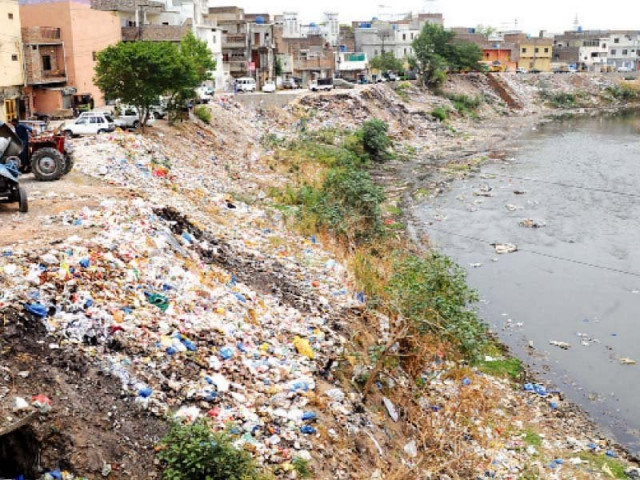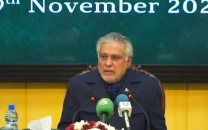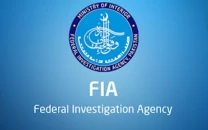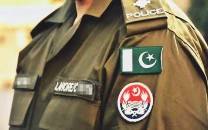Nullah Leh — how a stream turned into a fetid drain
Channel’s width narrowing with each passing year owing to illegal constructions, encroachments

Every year, as the pre-monsoon and rainy season approaches, it proves catastrophic for around 500,000 people living along the 18-kilometre-long Nullah Leh and 10 other drains.
As the monsoon season approaches, people start to move their valuables and livestock to safe places to avoid flooding in Nullah Leh and other storm drains.
The Pakistan Meteorological Department’s forecast of heavy and torrential rains in the coming monsoon has already hung a cloud of fear over the entire neighbourhood.
The river flows out of the Margalla hills, passes through Islamabad and falls into the Sawan River. It has a total length of 18-kilometre while it’s 300 to 700 meters width has been reduced to 500 meters because of encroachments.
Once a small river and major source of clean water from 1800 to 1920 has virtually turned into a foul-smelling drain. According to historians, its water used to be clean that Muslims would perform ablution and Hindus immersed cremated ashes in the river. According to historians, Aryans also lived along the banks of the once crystal clear water, and the 300-year-old Arya Mohalla in Rawalpindi has been named after them.
The caravan of Sher Shah Suri, on its way from Afghanistan to the subcontinent, stayed for two days near Liaquat Bagh along the same large transparent stream. The largest crematorium (Shamshan Ghat) of the Hindu community existed near Pirwadhai, away from the city. Here the Hindu community used to burn the dead and their ashes were dumped in this clear river near Liaquat Bagh, Gawalmandi, Mohanpura. The women of the vicinity used to come and bathe and wash their clothes in this river. The first flood in Nullah Leh occurred in 1894. It was the first and most severe flooding. At that time the population of Rawalpindi was very small. However, the flood washed away both the bridges of Leh near City Saddar Road and Murree Road Rialto.
In total, a total of 14 major and minor floods have occurred in Nullah Leh so far. The floods of 1971, 1975, 1987, 1990, 1995 and 2001 were more dangerous and devastating. The catastrophic floods of 1971 in Nullah Leh and 10 rain drainages killed 26 people and hundreds of cattle and destroyed 59 houses completely. The floods of July 23, 2001, were the most devastating, which killed 96 people, and 350 cattle and destroyed 310 buildings
During the flooding, in the past, every ruler from Muhammad Ayub Khan to Pervez Musharraf visited the Nullah Leh and made big announcements to solve the flooding issue facing the populace, but once the floodwaters receded, such announcements vanish into thin air. No government has been able to solve the biggest problem of flooding in Rawalpindi.
Each government, in the past, announced plans to build the Leh expressway and a flood channel but nothing has been done practically in this regard.
Terrible floods occur every five to seven years and homes in low-lying areas get flooded.
In 2007, former president Pervez Musharraf laid the foundation stone of the Leh expressway, but as soon as the PML-N government was formed in 2008, Shahbaz Sharif, as the Punjab chief minister, ended the project by declaring it a waste of funds. At that time, the cost of Leh express had been estimated at only Rs 17 billion which has now increased to Rs105 billion.
The project was revived in 2019 when the PTI government came to power. Legal and bureaucratic issues have not yet been resolved for the formal launch of the project.
Markazi Anjuman Tajiran-e-Rawalpindi President Sharjeel Mir said that the WASA wastes millions of rupees every year on cleaning the Nullah Leh. However, the soil that is extracted after the first rainfalls back to the drain and flooding occurs, which takes a heavy toll on traders and shopkeepers.
He said that hundreds of shopkeepers affected by the catastrophic floods of July 2001 were not compensated and are still trapped in debt. Despite the announcements, shopkeepers and families of the victims did not get financial support, he said. Anjuman-e-Tajiran Sabzi Mandi President Ghulam Qadir Mir said that as soon as the monsoon approaches, their legs start shaking.” In the monsoon, if it rains at night, we reach the market to see flooding.
Naveed Kanwal, the spokesperson for the Anjuman-e-Tajiran Moti Bazaar, said that whenever there is flooding, Moti Bazaar is devastated due to its being in close proximity to the nullah.
Former interior minister and MNA from the constituency, Sheikh Rasheed Ahmed said that the construction of the Leh expressway was the only solution to avoid flooding. “This will separate rainwater and sewage of the entire city and eliminate the risk of flooding forever,” he said adding that twice the expressway was approved and funds were allocated, but the PML-N government has put a full stop to the project for the second time.
Haji Fazal Dad, a resident of Nadeem Colony, the most vulnerable area for flooding, said he has been living there since 1962 and all rulers announced to solve the problem but none kept their promises. He said that they were left at the mercy of floods every year.
Nooraiz Akhtar, a resident of Javed Colony, said that no one has reached out to them to date. Nadeem and Javed Colony are the low-lying areas and during the flooding, houses submerge up to two floors here.
Published in The Express Tribune, May 24th, 2022.



















COMMENTS
Comments are moderated and generally will be posted if they are on-topic and not abusive.
For more information, please see our Comments FAQ